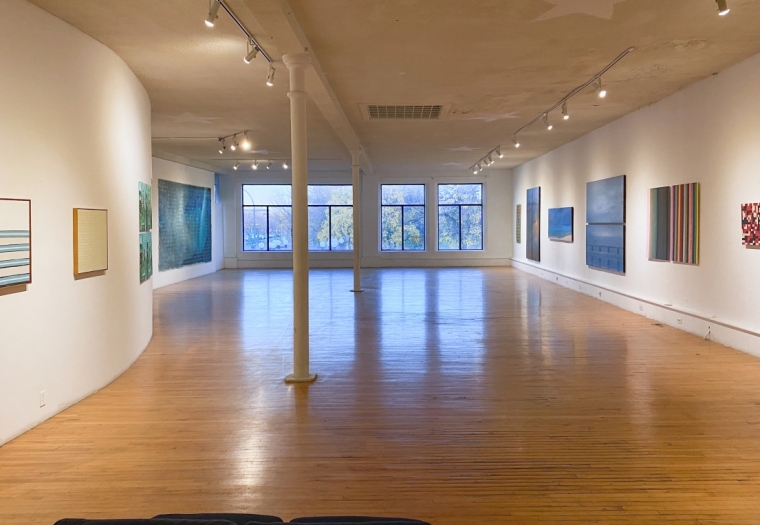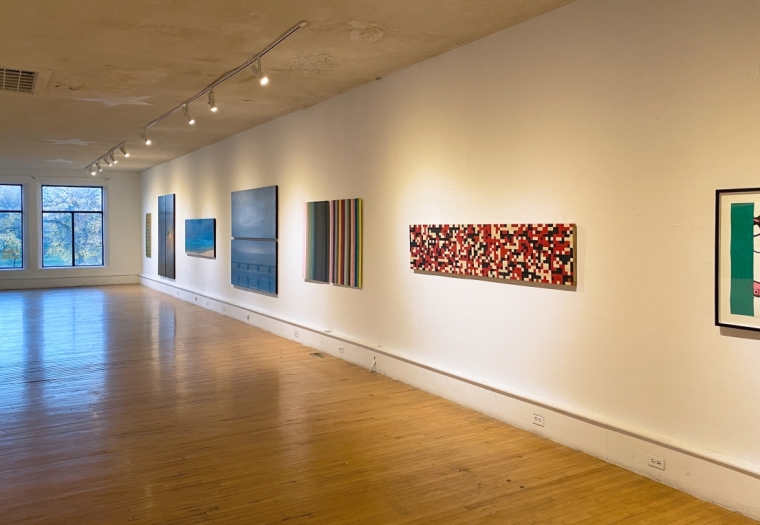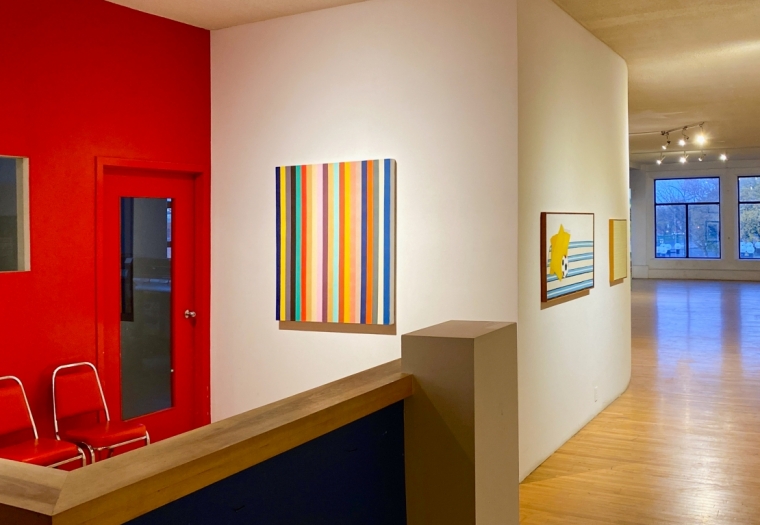Jeffrey Spalding - A Tribute.
WHAT WAS JEFFREY REVEALING BY HIDING?
Jeffrey’s earliest work was glowing with bright optimism, painted in veils of primary red, yellow and blue. They were experiments in colour theory, layered in transparent swatches, always on a triangular framework. The paintings were documentation for his thesis for a Master’s in Education at Ohio State University. He continued these as he arrived at NSCAD’s first MFA program, changing to a square format. Falling into the terse Post Conceptual thinking at NSCAD he began a process of striping away the paint on the square works, eliminating what he had previously done, and his first Removal paintings began. (1. Colour Theory painted 1973 removed 1976) Colour was still how he perceived each day but felt this was too obvious a declaration of mood so would choose a colour, paint it onto a square or the back of a stretcher and then at the end of the chosen allotment of time, usually a month, he would cover the entire surface with white gesso. (2. One Secret Colour Per Day, September 1978) These were the first of the Diary paintings.
The Removal series evolved where he applied a daily chosen colour on a square format and again after a chosen time frame he would use varying techniques; sanding or wiping with solutions to remove what had been previously applied. (3. Liquid Removal 1976) and on wall painted in layers. He also made mono prints off the surface of the removal piece in process lifting fragments of paint onto the paper. (4. Untitled transfer Rubbing 1977)
A series referred to as The Black Paintings were executed in Jeffrey’s final year at NSCAD; he returned to his layering of primary colour until the surface became black. They were titled for the final coat that had achieved the translucent black; Red, Yellow, Blue. They were shown at the SAAG in 1982.
Video was another medium that Jeffrey experimented with and was recognized for with a solo exhibition at the Art Gallery of Ontario in 1997 of the early 1970’s videos.
Jeffrey moved to Calgary to become curator of contemporary art at the Glenbow Museum and was stunned by the open, light landscape and the seemingly ‘stuck in time’ reverence of landscape painting. This spoke to his first love of Canadian historical art, and he felt conflicted as to how he would address it. Initially avoiding the land, he began with interiors based on the tile work he found in his rented home in Bridgeland. Other interiors dealt with darkened rooms looking through doors and corridors towards a glow or out of the grid of a window at buildings. At one-point objects were introduced with hidden meaning. (5. Ball at Rest 1981) A trip to California placed objects onto an empty beach using a picture window as frame and his first use of landscape emerged.
Jeffrey was still struggling with his desire to address ‘the land’ and realized it needed a representation that was recognizable and powerful, his chosen subject was Niagara Falls. He began with built up spray in the tile paintings (6. After the Shower 1981) and finally permitted himself a representation of the Falls with a semicircular barrier. This painting was three years in process. A large and very powerful version, with the dark barrier removed, hangs in the lobby of the Water Centre in Calgary.
Buildup of layers of acrylic was experimented with, almost a challenge to see how much could be applied and included substances such as sand to add texture. (7. Trap 1983) He had recently moved to Lethbridge and was busy with the University gallery and teaching classes so his only time to paint was at night. His imagery settled into a darker atmosphere with a glow emitting from a light source, television, nightlight, moon. Jeffrey had also found he could address Niagara Falls directly using night as the metaphor to set apart ‘pure’ landscape rendering. (8. Night Fall 1984)
A series of dark Niagara Falls paintings evolved and became his most recognized series. At one point he used a mahogany door panel for one of the Niagaras, the surface grain perfectly alluding to the water’s movement. (9. Passage 1990)
A new series and technique evolved where hundreds of layers were built upon each other now using transparent colour and the wood grain to build an image of a landscape. A separate series was created as Jeffrey found an image in a of what looked to be smoke rising. He tore out the photo never reading the caption and Event Yellow, Event Red and Event Blue came into being. A fan brush was used to apply the layers building a unified surface, eliminating texture caused by brush strokes. He continued using this technique for many years. (10. Salmon River Bridge) (11. Tigers of Autumn)
An excursion up to Comox Glacier in summer 1988 had a strong effect upon his work and he created a sublime ethereal body of work afterwards, using the layered transparencies on canvas and use of soft chalk pastels on paper.
Jeffrey also created a series where he would grid off the surface and paint either two or four versions of the same image rotating the piece for each iteration. (12. Double Source 1997/98)
Jeffrey was never one to work on one idea at a time and thus also worked on several types of coded paintings. One series took the alphabet and gave the letters a colour, as in, A was red, B was black, C was titanium white, and D a mixture, E would again be red, F black and so on. He then would take a written text and mark out a grid on a gessoed wooden panel and tape it off. (13. True Souvenirs 1997) Another series involved taping lines onto a canvas where he would start the piece off with a colour he felt marked the day; he then passed the work on to others for their choices. These works included (14. Untitled 2014) done at a residency in Zhangjiajie, Hunan, China and (15. Havana Late Bloom 2015) in Cuba. (16. Nouvelle Image/Neues Bild 2012) was performed over a span of 5 days in Montreal for the Biennial: every day adding a new panel with a strip of colour.
While searching for midcentury modern furniture in Florida he came across a stack of paintings that looked identical yet as he looked closer, he realized they had been individually painted, no doubt on an assembly line of painters. He purchased all 16 and added a grid onto them hoping to point out the individual qualities of each. (17. Monet’s Path 1998). He organized them into gridded groupings. This started him on what he felt was a rescue of amateur painters’ works by applying grids or surface dots to create another plane through which to look at the painting below. At one point adding a grid of camouflage or coloured duct tape for added texture. (18. Black Forrest 2010) (19. Split Decision 2011) (20. Homer Camouflage 2011) (21. Wild Iris 2009) was saving a work that Marianne Gerlinger had started but was dissatisfied with and thus this became referred to as The Rescue Series.
Jeffrey’s last works were of a more conceptual nature working in tandem with master printer Gordan Novak. The first series, Angels and Demons, requested Gordan to print whatever leftover ink he had from a series he was working on at random onto paper. He was then to not look at them until Jeffrey had and then they together chose a title. (22. Print at Top of Stairs) Another was using misprints that Gordan had from previous runs, and Jeffrey would decide what should be applied on top, usually stripes that he felt addressed the original. (23. Plague) He had begun a print with Gordan, of Niagara Falls, which is still in Admiral Saskatchewan. It strikes me as poignant as he had come back to address a subject that was most powerful, frightening and meaningful to him, perhaps he had a sense of what was to pass.
Exhibition essay by Marianne Gerlinger.
Jeffrey Spalding, a Tribute will run from November 5 through to the end of December.


